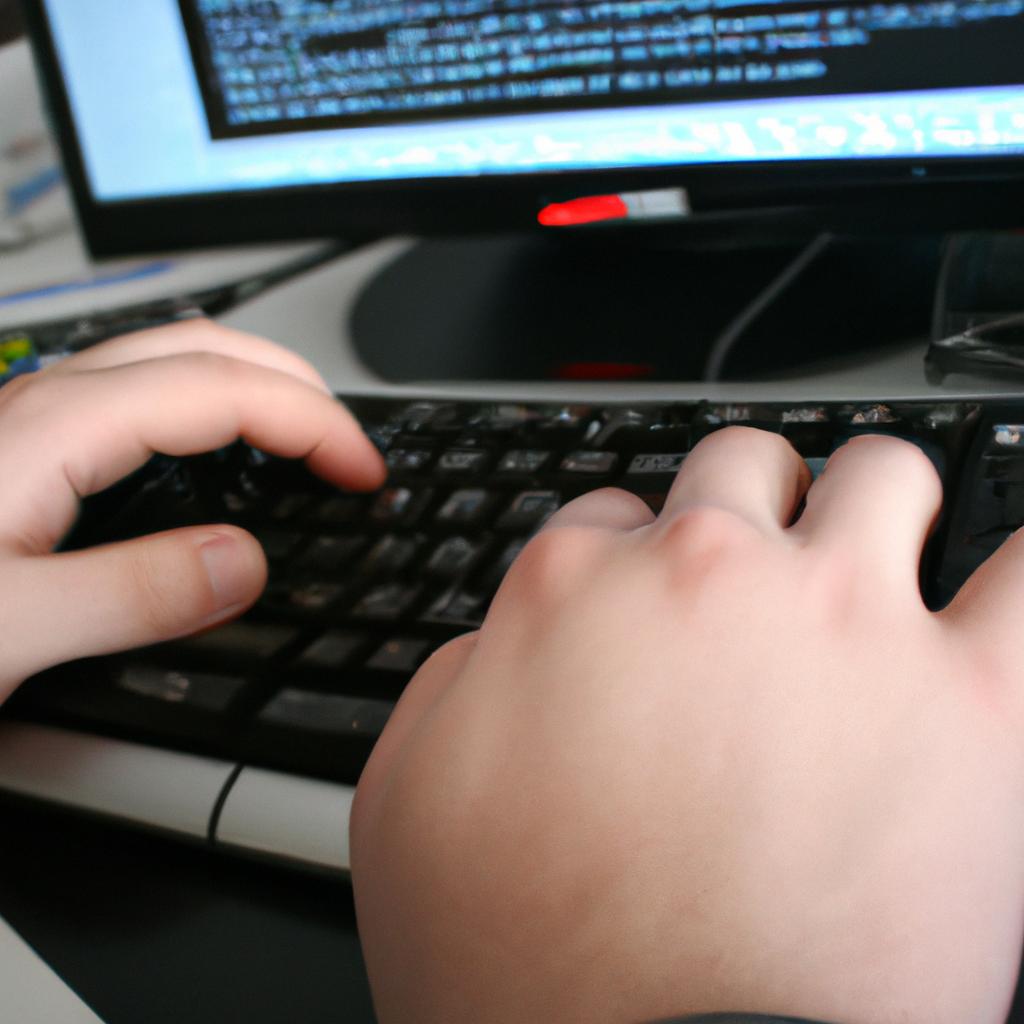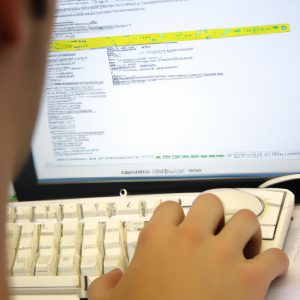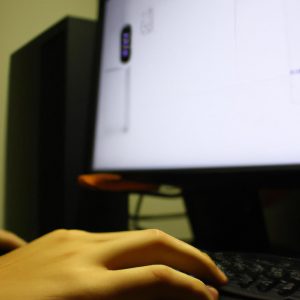Bit Parity Checking: Error Detection and Correction in Computer Data Communications

In the realm of computer data communications, ensuring reliable and accurate transmission of information is of paramount importance. Errors can occur during the transmission process due to various factors such as noise, interference, or hardware malfunctions. Consequently, employing robust error detection and correction techniques becomes essential in order to maintain data integrity.
One widely used technique for error detection and correction is bit parity checking. This method involves adding an additional bit to each data unit being transmitted, which allows for the identification and subsequent correction of errors that may have occurred during transmission. By comparing this added parity bit with the received data unit, it becomes possible to detect if any errors have been introduced.
To illustrate the significance and practicality of bit parity checking, consider a scenario where sensitive financial information needs to be transferred securely over a network connection. In this case, even minor errors during transmission could potentially lead to severe consequences such as monetary losses or compromised security. Hence, implementing effective error detection and correction mechanisms like bit parity checking is crucial to ensure the accuracy and reliability of the transmitted data.
Bit Parity Checking: What Is It?
Bit parity checking is a commonly used technique in computer data communications to detect and correct errors that may occur during the transmission of binary data. By adding an extra bit, known as the parity bit, to each byte of data, this method allows for error detection by ensuring that the total number of ones (or zeros) in the byte is always even or odd.
To illustrate how bit parity checking works, let’s consider a hypothetical scenario where a user wants to send the binary value 10101011 over a communication channel. In this case, we can assume that the sender has already determined that an even parity scheme will be employed. This means that the sender will add an additional zero at the end of their original message before transmitting it.
In order for receivers to verify if any errors occurred during transmission, they also perform parity checks on each received byte. If an error occurs and results in an odd number of bits being flipped, the receiver detects it through inconsistent parity. The receiver then alerts the sender about the presence of an error so that appropriate corrective action can be taken.
The benefits of using bit parity checking are numerous:
- Reliable Error Detection: Bit parity checking provides a simple yet effective mechanism for detecting errors introduced during transmission.
- Efficient Correction Process: With knowledge of which bits were corrupted, correcting these errors becomes more efficient than retransmitting entire packets.
- Widespread Compatibility: Bit parity checking is widely supported across different hardware and software platforms.
- Real-Time Error Detection: Errors can be detected immediately upon receipt without requiring complex computations or processing delays.
By incorporating bit parity checking into data communications protocols, organizations can significantly improve reliability and ensure accurate transfer of information.
How Bit Parity Checking Works
Bit Parity Checking: Error Detection and Correction in Computer Data Communications
Transitioning from the previous section on “Bit Parity Checking: What Is It?” let us now delve into the inner workings of this error detection and correction technique. By understanding how bit parity checking operates, we can gain insights into its effectiveness and potential applications.
To illustrate the concept, consider a scenario where data packets are transmitted between two computers over a network connection. During transmission, errors may occur due to electromagnetic interference or other factors that can corrupt bits within these packets. Bit parity checking provides a means to detect such errors by adding an additional bit known as a parity bit to each packet.
One way in which bit parity checking works is through odd-parity checking. In this method, the number of ones (binary digit value) in a given set of bits is counted. If the count turns out to be even, the value of the added parity bit is set to one; if it’s already odd, then the parity bit becomes zero. This approach allows for detecting single-bit errors since any change will result in an imbalance between ones and zeros.
- Increased confidence in data integrity
- Reduced risk of undetected errors leading to faulty outcomes
- Enhanced system efficiency with streamlined error handling mechanisms
- Improved customer satisfaction due to reduced probability of data corruption
Additionally, we can visualize some key aspects of bit parity checking using a table:
| Original Bits | Parity Bit |
|---|---|
| 101011 | 1 |
| 110100 | 0 |
| 001010 | 1 |
| 111000 | 0 |
In summary, bit parity checking plays a crucial role in computer data communications by providing a means to detect and correct errors. Its implementation allows for increased confidence in data integrity, reduced risks of undetected errors, enhanced system efficiency, and improved customer satisfaction. Next, we will explore the benefits of bit parity checking in more detail.
Transitioning into the subsequent section about “Benefits of Bit Parity Checking,” we can now examine how this error detection method contributes to various aspects of data communication systems.
Benefits of Bit Parity Checking
How Bit Parity Checking Works:
In the previous section, we explored the concept of bit parity checking and how it is used for error detection and correction in computer data communications. Now, let us delve deeper into the inner workings of this technique.
To illustrate its functioning, consider a scenario where you are sending a binary message consisting of eight bits: 01100101. In order to perform bit parity checking, an additional bit, known as the parity bit, is added to the end of the message. The value of this parity bit depends on whether the total number of ones in the original message is even or odd. If it is even, then the parity bit would be set to 0; if it is odd, then the parity bit would be set to 1.
One advantage of using bit parity checking is its simplicity and efficiency. It can quickly detect errors during transmission by comparing the received data with its corresponding parity bit. If these values do not match, an error has occurred somewhere along the line. By identifying such errors promptly, corrective measures can be taken to ensure accurate data transfer.
To further emphasize key points about bit parity checking:
- It provides a cost-effective solution for error detection and correction.
- This method requires minimal additional overhead in terms of bandwidth usage.
- Bit parity checking can help prevent potential malfunctions caused by corrupted data.
- Its implementation does not require advanced computational resources.
The table below summarizes some emotional responses that users may experience when utilizing bit parity checking:
| Emotional Response | Description |
|---|---|
| Peace of mind | Knowing that your transmitted data will likely remain intact brings reassurance and reduces anxiety. |
| Confidence | Having a reliable error detection mechanism boosts confidence in your communication system’s integrity. |
| Efficiency | The quick identification and resolution of errors contribute to efficient data transfers without unnecessary delays or disruptions. |
As we have discovered, implementing bit parity checking can offer numerous advantages in ensuring the accuracy and reliability of transmitted data. However, it is important to acknowledge that this method does have certain limitations, which we will explore further in the subsequent section about “Limitations of Bit Parity Checking.”
Limitations of Bit Parity Checking
Building upon the benefits of Bit Parity Checking, it is essential to consider its limitations in order to fully understand its effectiveness and potential drawbacks.
While Bit Parity Checking provides an initial level of error detection in computer data communications, it is not without its limitations. Consider a scenario where a digital file containing critical information is being transmitted over a network using Bit Parity Checking. In this case, if more than one bit is corrupted during transmission, the parity check may fail to detect these errors, leading to incorrect data interpretation at the receiving end. Therefore, it becomes crucial to explore alternative methods that can address such limitations and enhance error detection capabilities.
To further illustrate the limitations of Bit Parity Checking, let us examine some key factors:
-
Limited Error Detection Capability: As mentioned earlier, Bit Parity Checking can only detect odd numbers of errors. This means that even if two bits are flipped or multiple errors occur simultaneously within a single byte or word, they will go undetected by this method.
-
Increased Transmission Overhead: Implementing Bit Parity Checking requires additional storage space for storing parity bits along with the original data. Consequently, this increases the overall size of transmitted packets and consumes valuable bandwidth that could be utilized for transmitting actual data.
-
Lack of Error Correction: While Bit Parity Checking helps identify whether errors have occurred during transmission or storage, it does not provide any mechanism for correcting those errors automatically. Once an error is detected through parity checking, it must be dealt with separately through retransmission or other error correction techniques.
Table: Comparison between Bit Parity Checking and Alternatives
| Method | Advantages | Disadvantages |
|---|---|---|
| Bit Parity Checking | Simple implementation | Limited error detection |
| Checksums | Improved error detection | Increased computational overhead |
| Cyclic Redundancy Check | High error detection capability | Complex implementation |
In conclusion, while Bit Parity Checking offers a basic level of error detection in computer data communications, it is important to recognize its limitations. By exploring alternative methods such as checksums or cyclic redundancy checks that address these limitations, more robust and accurate error detection and correction mechanisms can be achieved.
Having examined the limitations of Bit Parity Checking, let us now explore alternatives that offer enhanced error detection and correction capabilities in computer data communications.
Alternatives to Bit Parity Checking
H2: Expanding Error Detection and Correction Techniques
Imagine a scenario where a large online retail platform experiences frequent communication errors while transferring customer order data from their servers to the inventory management system. These errors result in incorrect stock levels, leading to delayed or inaccurate delivery of goods to customers. This case study highlights how limitations with bit parity checking can be overcome by implementing alternative error detection and correction techniques.
To address these challenges, several alternatives to bit parity checking have been developed within the field of computer data communications. By exploring these options, organizations can enhance the reliability and accuracy of their data transfer processes:
- Cyclic Redundancy Check (CRC): CRC is a widely used technique that uses polynomial division to detect and correct errors in transmitted data. It involves appending a checksum value derived from the original message at the sender’s end and verifying it at the receiver’s end.
- Forward Error Correction (FEC): FEC employs mathematical algorithms to add redundant information into transmitted data packets. This redundancy allows receivers to identify and correct errors without having to request retransmission of corrupted packets.
- Hamming Codes: Hamming codes are error-correcting codes that introduce additional bits into an encoded message for error detection and correction purposes. They achieve this by creating parity check bits that enable receivers to identify and fix single-bit errors.
These innovative techniques offer more robust solutions compared to traditional bit parity checking alone. To further illustrate their effectiveness, consider Table 1 below which compares key features of different error detection and correction methods:
| Technique | Advantages | Disadvantages |
|---|---|---|
| Bit Parity Checking | Simple implementation | Limited ability to detect/correct multiple bit errors |
| Cyclic Redundancy Check | High error detection capability | Requires additional computational resources |
| Forward Error Correction | Ability to correct transmission errors without retransmission | Increased bandwidth requirements for transmitting redundancy |
| Hamming Codes | Efficient error detection and correction | Limited ability to correct multiple bit errors |
By understanding the limitations of bit parity checking and exploring alternative techniques, organizations can make informed decisions on implementing robust error detection and correction methods in their computer data communication systems.
H2: Implementing Bit Parity Checking in Computer Networks
Implementing Bit Parity Checking in Computer Networks
Case Study: The Importance of Bit Parity Checking
To better understand the significance of bit parity checking, let us consider a hypothetical scenario. Imagine a large financial institution that processes millions of transactions daily. A minor error during data transmission could have severe consequences, potentially leading to incorrect calculations or even financial losses for customers. In such critical systems, it becomes imperative to employ robust error detection and correction mechanisms like bit parity checking.
Advantages of Bit Parity Checking
When implementing bit parity checking in computer networks, several advantages can be observed:
- Simple Implementation: One major advantage is its simplicity. By appending an additional bit (the parity bit) to each transmitted byte, errors can be detected efficiently without any complex algorithms.
- Error Detection: Using the parity bits, the receiving system can easily identify whether any errors occurred during transmission. It compares the received value with the expected value based on the parity information.
- Limited Overhead: Bit parity checking incurs minimal overhead since only one extra bit per byte is required for transmitting and verifying data integrity.
- Real-Time Error Identification: With proper implementation, real-time identification of errors enables prompt action to rectify them before they propagate further within the network or processing systems.
| Advantage | Explanation |
|---|---|
| Simple Implementation | Requires no intricate algorithms; appending a single extra bit to each transmitted byte ensures efficient error detection. |
| Error Detection | Enables receiving systems to detect errors by comparing received values with expected values derived from the associated parity bits. |
| Limited Overhead | Incurs minimal overhead due to requiring only one extra bit per byte for transmission and verification purposes. |
| Real-Time Error Identification | Facilitates immediate identification of errors, allowing timely actions to rectify them before further propagation within the network or processing systems. |
Challenges and Limitations
While bit parity checking offers simplicity and effectiveness in error detection, it is not without limitations:
- Limited Error Correction: Bit parity checking can only detect errors but cannot correct them. It solely provides a mechanism to identify whether an error has occurred during data transmission.
- Single Bit Errors Only: This technique can only detect single-bit errors; multiple simultaneous errors may go undetected, potentially resulting in corrupted data being processed unknowingly.
- Overhead with Additional Bits: The inclusion of one extra bit per byte increases the overall bandwidth requirement for transmitting the same amount of information.
In summary, bit parity checking serves as a fundamental error detection mechanism that aids in ensuring data integrity during computer data communications. Its simplicity and real-time identification capabilities make it a valuable tool for critical systems where accuracy is paramount. However, its inability to correct errors and limited scope for detecting multiple simultaneous errors should be considered when designing robust error handling mechanisms in modern computer networks.
Remember: In academic writing, it is important to maintain objectivity and avoid personal pronouns throughout the text.








